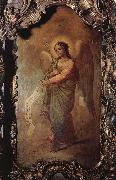Wholesale Oil Painting No Minimum |
|||||||||||
|
|
|||||||||||

|
|||||||||||
|
|
|
||||||||
Nicolae GrigorescuRomanian Painter, 1838-1907 From 1848 he trained in Bucharest with various church painters, producing icons and religious mural decorations. These works, which soon attracted attention, were influenced in style by the Viennese classicism widespread in the Romanian principalities in the early 19th century and by the Italian academicism established there after 1850 by Gheorghe Tattarescu. The earliest of his known paintings are in the church of SS Constantin and Elena at Baicoi, where his signature can be seen beside that of Nita Pereescu on the icon of St George (1853). He subsequently painted a series of icons (1854-5) at Caldarusani Monastery. In the later ensembles he was assisted by his older brother Georghe Grigorescu, who participated under his direction in the decoration of churches, such as those of the Zamfira (1856-8) and Agapia (1858-60) monasteries. In Nicolae's paintings at Agapia, classicism in Romanian art reached its highest point. The royal icons are distinguished for the elegance of the figures, both in their attitudes and in their drapery. |
||||||||
|
|
||||||||
Archangel Gabriel
Archangel Gabriel Painting ID:: 30718 |
nn06
Oil on wood
Zamfira Monastery
nn06 Oil on wood Zamfira Monastery |
|||||||
|
|
||||||||
Piero della FrancescaItalian Early Renaissance Painter, ca.1422-1492 Italian painter and theorist. His work is the embodiment of rational, calm, monumental painting in the Italian Early Renaissance, an age in which art and science were indissolubly linked through the writings of Leon Battista Alberti. Born two generations before Leonardo da Vinci, Piero was similarly interested in the scientific application of the recently discovered rules of perspective to narrative or devotional painting, especially in fresco, of which he was an imaginative master; and although he was less universally creative than Leonardo and worked in an earlier idiom, he was equally keen to experiment with painting technique. Piero was as adept at resolving problems in Euclid, whose modern rediscovery is largely due to him, as he was at creating serene, memorable figures, whose gestures are as telling and spare as those in the frescoes of Giotto or Masaccio. His tactile, gravely convincing figures are also indebted to the sculpture of Donatello, an equally attentive observer of Classical antiquity. In his best works, such as the frescoes in the Bacci Chapel in S Francesco, Arezzo, there is an ideal balance between his serene, classical compositions and the figures that inhabit them, the whole depicted in a distinctive and economical language. In his autograph works Piero was a perfectionist, creating precise, logical and light-filled images (although analysis of their perspective schemes shows that these were always subordinated to narrative effect). However, he often delegated important passages of works (e.g. the Arezzo frescoes) to an ordinary, even incompetent, assistant. |
||||||||
|
|
||||||||
|
|
Archangel Gabriel
Archangel Gabriel Painting ID:: 91673 |
1445(1445) and 1462(1462)
Medium oil and tempera on panel
Dimensions Height: 55 cm (21.7 in). Width: 21 cm (8.3 in).
cyf 1445(1445) and 1462(1462) Medium oil and tempera on panel Dimensions Height: 55 cm (21.7 in). Width: 21 cm (8.3 in). cyf |
||||||
|
|
||||||||
|
Piero della Francesca Italian Early Renaissance Painter, ca.1422-1492 Italian painter and theorist. His work is the embodiment of rational, calm, monumental painting in the Italian Early Renaissance, an age in which art and science were indissolubly linked through the writings of Leon Battista Alberti. Born two generations before Leonardo da Vinci, Piero was similarly interested in the scientific application of the recently discovered rules of perspective to narrative or devotional painting, especially in fresco, of which he was an imaginative master; and although he was less universally creative than Leonardo and worked in an earlier idiom, he was equally keen to experiment with painting technique. Piero was as adept at resolving problems in Euclid, whose modern rediscovery is largely due to him, as he was at creating serene, memorable figures, whose gestures are as telling and spare as those in the frescoes of Giotto or Masaccio. His tactile, gravely convincing figures are also indebted to the sculpture of Donatello, an equally attentive observer of Classical antiquity. In his best works, such as the frescoes in the Bacci Chapel in S Francesco, Arezzo, there is an ideal balance between his serene, classical compositions and the figures that inhabit them, the whole depicted in a distinctive and economical language. In his autograph works Piero was a perfectionist, creating precise, logical and light-filled images (although analysis of their perspective schemes shows that these were always subordinated to narrative effect). However, he often delegated important passages of works (e.g. the Arezzo frescoes) to an ordinary, even incompetent, assistant. Archangel Gabriel 1445(1445) and 1462(1462) Medium oil and tempera on panel Dimensions Height: 55 cm (21.7 in). Width: 21 cm (8.3 in). cyf |
||||||||
|
|
||||||||
|
Prev Next
|
||||||||
|
|
||||||||
|
Related Paintings to Piero della Francesca :. |
||||||||
|
|
||||||||
|
CONTACT US |


